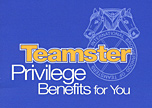|

What is a union?
A union is a group of employees who join together within a company to bargain collectively for better wages, stronger benefits and safer working conditions.
What do unions do?
A union’s primary objective is to secure good contracts for its members and to enforce the provisions of that contract. The union also administers some of the contract's important benefits directly. Often these include health plans, pensions and labor/management partnerships and trusts. See The Teamster Contract.
How do you organize with the Teamsters?
Employees who want to join the Teamsters sign a “union authorization card.” When a majority of employees sign cards, they are forwarded, in most cases, to the National Labor Relations Board
When the union is certified, the company is required by law to bargain over wages, benefits and working conditions. The laws governing public sector and the airline industry are different. See Getting Started (NLRB). The NLRB then schedules and conducts a secret ballot election. In some cases, when a majority of workers sign cards the company will recognize the union.
If I sign an authorization do I have to vote yes in the election? What if I change my mind?
The Teamsters are committed to organizing workers that want Teamster representation. Organizing is not about holding a vote; it is about gaining a voice in the workplace.
When the NLRB conducts a union election it's a secret ballot. No one has any right to know how you voted.
How does the union work out problems with management?
Through the grievance procedure. The contract spells out what the grievance procedures are and explains how conflicts are to be resolved.
When management engages in unfair conduct or violates a a provision of the contract there are steps spelled out in the contract to resolve the problem. First, talk with your supervisor. When he or she refuses to do anything about it, go to your Teamster shop steward for help. The steward sits down with you and management and tries to talk about the issue. If it can't be resolved at this meeting, a business agent from the union approaches the company to discuss the issue. If the problem still cannot be resolved to everyone's satisfaction, the business agent appeals to upper management. If this step fails, both parties bring in a neutral arbitrator to hear evidence and order a final resolution of the problem.
What are shop stewards and business agents?
A shop steward is one of your co-workers, who acts as an agent of the union in the workplace. The union membership and the Teamster local union determines procedures for electing shop stewards and negotiates how many stewards are in each job location, shift and department. The steward's job is to make sure your company lives up to your contract. When there is a problem with management and you need union help, your first stop should be a visit with your shop steward.
A business agent is an official of your local union who handles any problems the shop steward cannot.
What is a “bargaining unit”?
A bargaining unit is made up of all the employees who are eligible to vote for and be in the union.
Who negotiates your contract?
The Teamsters and the company each choose their own negotiators. The company's team is usually comprised of lawyers, local management and upper management officials. The union team usually consists of bargaining unit employees and expert union negotiators. See Contract Negotiations.
What kind of say do I get in the contract?
Before contract talks start, the union asks you what you'd like to see in a contract. Usually the union sends out a survey to all a bargaining unit's members. Once the contract has been negotiated it's submitted to you and your co-workers for ratification. If a majority doesn't approve of the contract, your negotiating team goes back to the drawing board.
How long do contracts last?
Usually 3 to 5 years.
What are union dues? What are they used for?
Union dues are the money you pay to the union to help pay for support staff, legal costs, negotiation costs, arbitrator's fees, etc. See Facts About Dues.
What’s a “local”?
The Teamsters have a structure that includes a national body, intermediaries, and local unions. Most decisions are made at the state and local union level. See Teamster Structure.
So what does the “International” do?
The International's responsibilities include; lobbying Congress for laws that benefit workers, sending help to locals that need it and coordinating national organizing efforts.
How democratic are unions?
The whole process is open and democratic. You decide if you want to sign an authorization card. You decide whether to vote "yes" on joining the union. You decide which co-workers you want on your negotiating team. You decide what to tell your negotiators you want in a contract. You vote on the contract once it's negotiated. You vote on who will be your shop steward. You vote on who will be the officers of your local.
|
 Forming a union at your workplace gives you and your coworkers the power to stand up for your families, your futures and yourselves. Through a legal, binding contract it gives you a strong, collective voice with which to demand decent working conditions, with fair pay and benefits.
Forming a union at your workplace gives you and your coworkers the power to stand up for your families, your futures and yourselves. Through a legal, binding contract it gives you a strong, collective voice with which to demand decent working conditions, with fair pay and benefits.
















